Science is not just a body of knowledge that reflects current understanding of the world. It is also a set of practices used to establish, extend and refine that knowledge. Both elements – knowledge and practice – are essential. Students in our elementary grade classroom participate in science instruction that supports their ability to develop an understanding of four core ideas: physical sciences; life sciences; earth and space sciences; and engineering, technology, and learn about the applications of science. In early elementary grades, students learn to recognize patterns and formulate answers to questions about the world around them. In subsequent grades, our students learn and demonstrate growing proficiency in gathering, describing, and using information about the natural and designed world. They learn to structure simple explorations of their own and discover the ways that scientific inquiry can enhance their own lives.
Key elements of the scientific inquiry that our students encounter include:
Science instruction offers increased opportunities to complement other content areas. For example, science involves skills introduced in mathematics, such as measuring and comparing quantities. Science incorporates skills learned in English-Language Arts (ELA) such as reading informational text and composing brief informative and explanatory texts.
Our science curriculum sets an active collaborative learning context that is well suited for Bridge School students who are practicing assistive technologies and supports while learning scientific knowledge and practices. Importantly, science is fundamentally a social activity, and scientific knowledge advances through collaboration. Individual scientists may do much of their work independently or they may collaborate closely with colleagues. Thus, new ideas can be the product of one mind or many working together. In order for students to appreciate the many ways in which science is relevant to their daily lives, science instruction connects with their own interests and experiences. Science tends to be very hands-on as students observe, manipulate and explore objects and materials. Because of this emphasis, Bridge School teachers routinely adapt materials and provide additional accommodations that maximize each student’s active participation and learning. Students apply their communication skills as they ask questions, engage in discussions and use augmentative communication systems to express ideas and findings. Just as real world scientists approach their work, our students are encouraged to interact frequently with their teachers and peers, both formally and informally. They may exchange emails, post blogs, engage in discussions in large and small groups, share procedures and present and respond to ideas in posters and reports.

After the introduction, students explored using different tools like pulleys, inclined planes, hammers, and screws. As their final project, students designed and engineered their pencil holders by planning placement, number, and depth of holes to fit the pencils. Aidan’s favorite tool was the hammer!
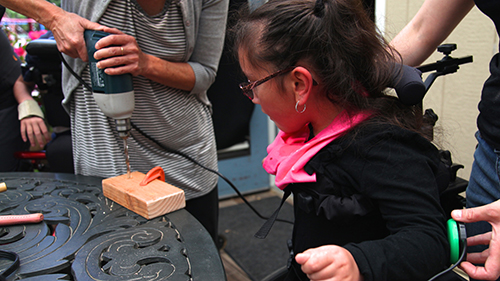
Savannah is drilling the holes for her pencil holder. Her teacher holds the drill while Savannah directs and runs the power for the drill. She uses a switch at her left elbow plugged into an AbelNet Powerlink which, when attached to the drill, allows Savannah to control the on/off switch of the drill’s motor.
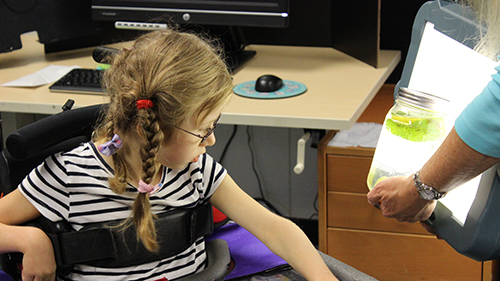
In Science students learn to make observations to gather information, make predictions, and communicate their experiences through thoughtful discourse. Abigail is looking at sediment at the bottom of a mixture of water, oil, and sand. After she’s made her observation she can accurately report how the items in the jar are ordered by weight from heaviest to lightest. Abigail is given extended time to look at the mixture and the jar is presented in front of a lightbox to support her use of vision.
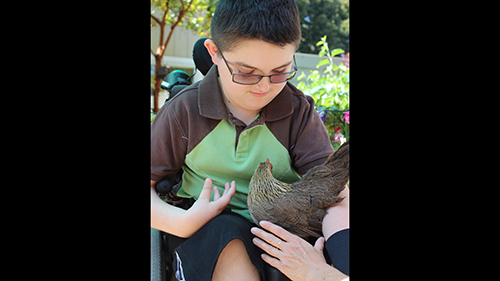
Personal experience with real objects and things allow a student to define what they see in their own words. Raul finds out chickens can be friendly and soft.
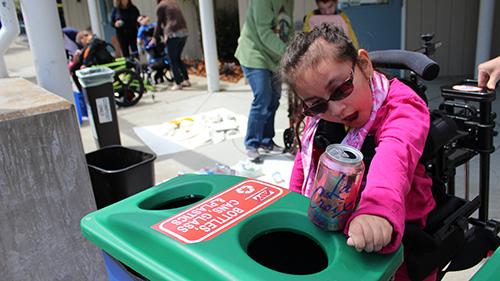
When students have the opportunity to explore science as part of a bigger world outside of their own classroom, they learn vocabulary that connects them to current events and issues in society. Savannah is learning how to sort trash for recycling for Earth Day. In her hands-free walker she can see the top of the bin and the holes, and the walker allows her to stand close enough to the bin to push the can into the opening.
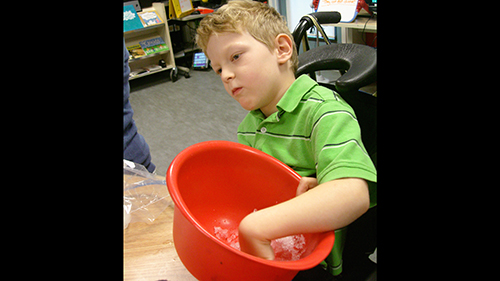
Students learn about the properties of snow as they make real snow by grinding ice in an ice machine. Jet’s feeling it so he can describe the snow’s temperature and texture.
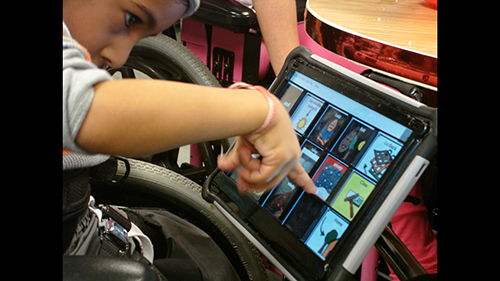
Arjun locates and says the word to describe his snow mixture experiment using his SGD.
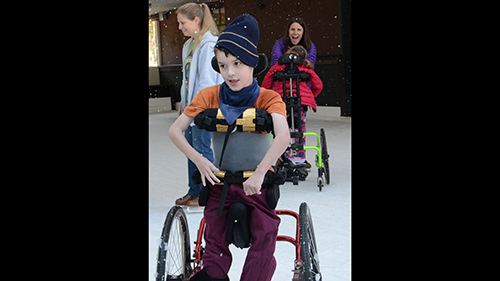
What better way to follow up units on Snow and Healthy Bodies than by going ice skating? Adam knows the ice on the rink is cold, but the artificial snow is not real because it’s not cold or wet! In their hands-free walkers, the students can enjoy the freedom of movement and feel of the ice beneath their feet.
Melver, l. and Heller, K.W. Science and Social Studies Instruction and Adaptations. In S. J. Best, K. W. Heller, And J. L. Bigge (2010.) Teaching Individuals with Physical or Multiple Disabilities. pp433-455.
Next Generation Science Standards for Today’s Students and Tomorrow’s Workforce http://www.nextgenscience.org/
Next Generation Science Standards for California Public Schools http://www.cde.ca.gov/pd/ca/sc/ngssstandards.asp
National Research Council. (2012). A Framework for K-12 Science Education: Practices, Crosscutting Concepts, and Core Ideas. Committee on a Conceptual Framework for New K-12 Science Education Standards. Board on Science Education, Division of Behavioral and Social Sciences and Education. Washington, DC: The National Academies Press.